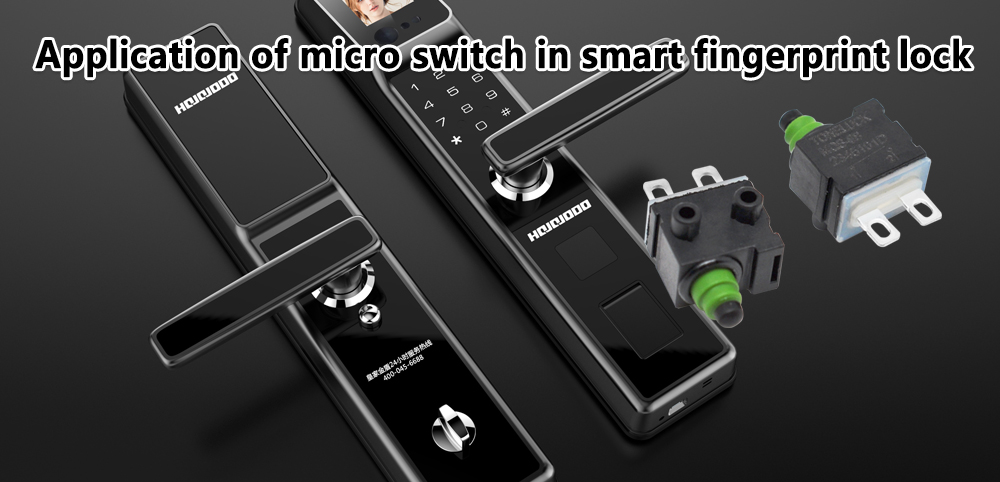Triggering of unlocking micro switch in smart fingerprint lock
Micro switches play an important role in smart fingerprint locks and are used to trigger and control various functions of the lock. Micro switches are often used inside the lock body and are connected to mechanical components such as the lock core or lock tongue. When the user passes correct authentication (such as fingerprint recognition) and enters a password, swipes a card, etc., the micro switch is triggered, causing the lock’s mechanical structure to unlock, allowing the door to open.
In smart fingerprint locks, the triggering of the micro switch is usually initiated by legal means after the user completes identity verification. The user first performs fingerprint recognition on the smart fingerprint lock. Through the built-in fingerprint sensor, the smart lock collects and compares the user’s fingerprint information. If the user’s fingerprint matches the pre-stored legal fingerprint, the authentication is successful.
In addition to fingerprint recognition, smart fingerprint locks usually support other authentication methods, such as password entry, card swiping, etc. Users can choose to authenticate using one of these methods. When the user’s identity verification is successful, the smart fingerprint lock will generate an authentication success signal. This signal will trigger the action of the micro switch.
The micro switch triggers the authentication success signal and transmits it to the micro switch through the circuit. Depending on the design, the microswitch may be configured to trigger when an authentication success signal is received. The triggering of the micro switch causes the mechanical structure inside the lock body to unlock. This may include actions such as releasing the deadbolt, unlocking the deadbolt, etc., allowing the door to open freely.
At the same time, the triggering of the micro switch may also trigger a status indicator light or other display device to notify the user that the lock has been successfully unlocked. The whole process is that after the user completes the identity verification, the smart fingerprint lock unlocks the mechanical structure by triggering the micro switch. This design improves security, because only after the legal identity verification is successful, the micro switch will be triggered to open the lock body.

Status indication in smart fingerprint lock
Micro switches can be used to detect the status of a lock, such as locked or unlocked. According to the status of the micro switch, the smart fingerprint lock can display corresponding information through the built-in indicator light or screen, so that the user can clearly understand the unlocking status.
Battery status monitoring in smart fingerprint locks
Smart fingerprint locks are usually powered by batteries, and micro switches can be used to monitor the status of the batteries. When the battery power is low, the micro switch can trigger the system to issue a warning to remind the user to replace the battery in time. In smart fingerprint locks, status indication is a means of conveying lock status information to users through different visual or auditory signals. This helps users understand the current status of unlocking, such as whether it was successfully unlocked, whether the battery needs to be replaced, etc.
Fingerprint locks are usually equipped with LED indicators, and lights of different colors can indicate different states. For example, a green light might indicate a successful unlock, a red light might indicate a failed unlock, and a yellow light might indicate a low battery or other warning. The smart fingerprint lock is equipped with a touch screen that can display detailed status information on the screen, such as successful unlocking, incorrect password, low battery, etc. This method provides more space for information display.
Smart fingerprint locks may be equipped with a buzzer or speaker to convey status information to the user through sound prompts. Different tones or audio signals can represent different states. Smart locks can also notify users of status changes through vibration feedback. For example, a successful unlock may have a short vibration, while a failed unlock may have a different vibration pattern.
Mobile application push notifications The smart fingerprint lock is connected to the mobile application, and push notifications can also be sent to the user through the mobile application when the lock status changes. The smart fingerprint lock is equipped with a digital display on the lock body, which can directly display password input, lock status and other information. The status indication method is usually implemented in combination with a micro switch and an electronic control unit. The user can determine the unlocking situation based on these instructions, which improves the visibility and convenience of the user’s use of the smart fingerprint lock.
Micro switches can also be used for safety detection, such as detecting whether a door is fully closed. If the door is not closed properly, a microswitch may trigger an alarm or alert the user to a safety issue through a notification system.
Touch panel control
Smart fingerprint locks have a touch screen or touch panel, and micro switches may be used to detect the user’s touch input. This helps achieve a user-friendly interface so that users can perform different functions like settings, change passwords, etc. through touch. Smart fingerprint locks usually have emergency alarm functions. Micro switches can be used to trigger emergency alarms, such as when there are too many incorrect passwords, illegal intrusion, or other security risks.
Micro switches realize the safe, convenient and user-friendly functions of the lock through triggering, detection and control in smart fingerprint locks. These switches play a key role in making locks smart and electronic.
